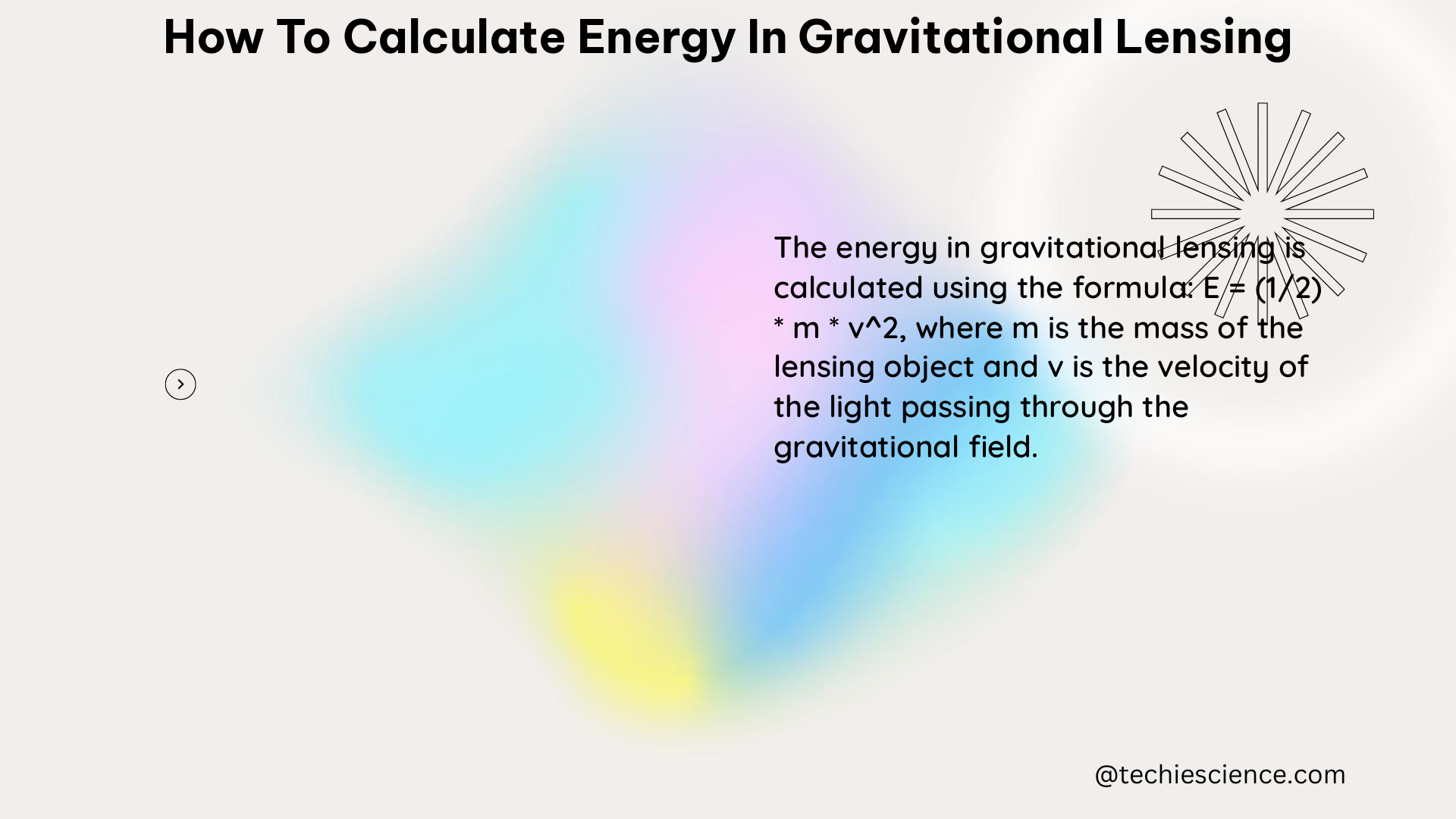Gravitational lensing is a fascinating phenomenon in which the gravity of a massive object, such as a galaxy or a cluster of galaxies, bends the path of light passing near it. This effect can be used to study the distribution of matter in the universe and to probe the nature of dark matter and dark energy. In this comprehensive guide, we will explore the step-by-step process of calculating the energy change in a light ray due to gravitational lensing.
Understanding the Deflection Angle
The key to calculating the energy change in gravitational lensing is the deflection angle of the light ray. According to general relativity, the deflection angle \(\hat{\alpha}\) for a light ray passing a distance \(b\) from a massive object of mass \(M\) is given by:
\[\hat{\alpha} = \frac{4GM}{c^2b}\]
where \(G\) is the gravitational constant and \(c\) is the speed of light. This equation is known as the Einstein deflection angle formula.
Calculating the Gravitational Redshift

When a light ray passes near a massive object, its frequency undergoes a change due to the gravitational redshift effect. The change in frequency \(\Delta\nu\) is related to the deflection angle \(\hat{\alpha}\) by the following equation:
\[\frac{\Delta\nu}{\nu} = \frac{\hat{\alpha}}{2}\]
where \(\nu\) is the original frequency of the light ray.
Determining the Energy Change
The energy of a light ray is proportional to its frequency, given by the equation \(E = h\nu\), where \(h\) is Planck’s constant. Using the equations for the deflection angle and the gravitational redshift, we can calculate the energy of the light ray after the deflection as:
\[E_\text{after} = h(\nu - \Delta\nu) = h\nu(1 - \frac{\hat{\alpha}}{2})\]
The energy of the light ray before the deflection is simply \(E_\text{before} = h\nu\). The change in energy due to the gravitational lensing effect is then:
\[\Delta E = E_\text{after} - E_\text{before} = -h\nu\frac{\hat{\alpha}}{2}\]
Substituting the expression for the deflection angle, we get the final formula for the change in energy:
\[\Delta E = -\frac{2GMh\nu}{c^2b}\]
This equation shows that the change in energy of the light ray is proportional to the mass of the deflector, the frequency of the light ray, and inversely proportional to the impact parameter.
Example Calculation
Let’s consider a specific example to illustrate the calculation. Suppose we have a light ray passing a distance of \(10^{10} m\) from a massive object with a mass of \(10^{11} M_\odot\), where \(M_\odot\) is the mass of the Sun. The frequency of the light ray is \(10^{14} Hz\).
Plugging in the values, we get:
\[\Delta E = -\frac{2\times10^{11}\times6.63\times10^{-34}\times10^{14}}{(3\times10^8)^2\times10^{10}} \approx -4.42\times10^{-22} J\]
This is a very small change in energy, but it can be measured using sensitive instruments.
Factors Affecting the Energy Change
The change in energy of the light ray due to gravitational lensing is influenced by several factors:
-
Mass of the Deflector: The energy change is directly proportional to the mass of the deflecting object. Larger masses result in a greater deflection and, consequently, a larger energy change.
-
Frequency of the Light Ray: The energy change is also directly proportional to the frequency of the light ray. Higher-frequency light will experience a more significant energy change.
-
Impact Parameter: The energy change is inversely proportional to the impact parameter, which is the distance of closest approach between the light ray and the deflecting object. Smaller impact parameters lead to larger energy changes.
-
Gravitational Constant: The energy change is directly proportional to the gravitational constant,
\(G\), which is a fundamental physical constant. -
Speed of Light: The energy change is inversely proportional to the square of the speed of light,
\(c^2\), which is another fundamental physical constant.
Understanding these factors is crucial in accurately calculating the energy change in gravitational lensing scenarios.
Applications and Implications
The study of energy changes in gravitational lensing has several important applications and implications:
-
Probing Dark Matter and Dark Energy: Measuring the energy changes in gravitational lensing can provide valuable insights into the distribution and properties of dark matter and dark energy, which are crucial components of the universe.
-
Studying Massive Objects: By analyzing the energy changes in light rays passing near massive objects, such as galaxies or galaxy clusters, we can gain information about the mass and structure of these objects.
-
Testing General Relativity: Precise measurements of energy changes in gravitational lensing can be used to test the predictions of general relativity, which is the fundamental theory of gravity.
-
Astronomical Observations: Gravitational lensing can be used as a tool to magnify and distort the images of distant astronomical objects, allowing us to study them in greater detail.
-
Gravitational Wave Detection: Energy changes in gravitational lensing can be used to detect and study gravitational waves, which are ripples in the fabric of spacetime predicted by general relativity.
In conclusion, the calculation of energy changes in gravitational lensing is a crucial aspect of understanding this fascinating phenomenon and its applications in modern astrophysics and cosmology.
References:
- A MEASUREMENT OF GRAVITATIONAL LENSING OF THE COSMIC MICROWAVE BACKGROUND, SPT, WMAP7, and ACT, https://arxiv.org/abs/1105.3143
- Gravitational lensing: a unique probe of dark matter and dark energy, https://arxiv.org/abs/1001.0785
- Gravitational lensing, Wikipedia, https://en.wikipedia.org/wiki/Gravitational_lensing

The lambdageeks.com Core SME Team is a group of experienced subject matter experts from diverse scientific and technical fields including Physics, Chemistry, Technology,Electronics & Electrical Engineering, Automotive, Mechanical Engineering. Our team collaborates to create high-quality, well-researched articles on a wide range of science and technology topics for the lambdageeks.com website.
All Our Senior SME are having more than 7 Years of experience in the respective fields . They are either Working Industry Professionals or assocaited With different Universities. Refer Our Authors Page to get to know About our Core SMEs.